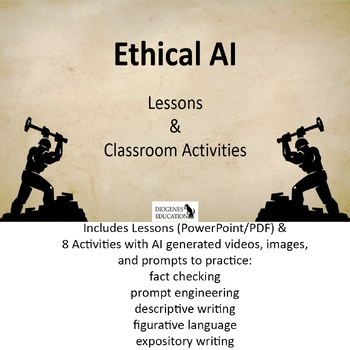Artificial Intelligence AI ChatGPT English Lesson RL.9-10.4 CCRA.L5 RI.11-12.7
- Zip
What educators are saying
Also included in
- Poetry, fiction, graphic novels, expository writing, research, activities, worksheets, assessments, posters, lessons--all printable and all time-saving. For any grade 9-10, native speaker or ESL, it's already differentiated with a tiered assessments: Pick and choose the difficulty as you go!It's allPrice $155.99Original Price $261.72Save $105.73
Description
Lessons for your students on the ethics and limitations of Artificial Intelligence use like ChatGPT: teaching English with prompt engineering. Also includes fun activities to incorporate AI-use in the classroom using ChatGPT and image-generators like Canva, Midjourney, or DALL-E for:
* Lesson on Understanding what A.I. actually is
* Lesson on Avoiding Plagiarism
* Reading and Writing comprehension - issues with AI essays
* Fact-checking and Source Analysis - issues with false data
* Creative Writing with Descriptive Imagery and Figurative Language
* Image generation using understanding of Connotation and Denotation
* AI Videos and research skills activity - the rise of auto-generated content and
problems that arise
teach Common Core Standards in English while also teaching prompt engineering, fact checking and research skills, and figurative language and descriptive imagery.
Includes a PowerPoint lesson with in-class activity prompts and discussions, student activity book in PDF format to print, teacher instructions.
Teach students how to use AI ethically without plagiarising, as well as the limits to ChatGPT and Large Language Models, encourage students to do their own writing and research, all while meeting the following common core standards:
CCRA.L.3, CCRA.L.5, CCRA.R.8, CCRA.W.6, CCRA.W.8, L9-10.5, L9-10.5a, L9-10.5b, RI.9-10.8, RL.9-10.4, L.11-12.5, RL.11-12.4, L.11-12.5a, L.11-12.5b, R.I.11-12.4, R.I.11-12.5, RI.11-12.7
==============
Check out our other lessons
- Can you spot plagiarism from ChatGPT?: AI Plagiarism Detection PD
- For other lessons on Figurative Language: Literary Devices Unit
- For other lessons on Fact Checking Sources: Media Literacy and Sources
- For a lesson on writing without ChatGPT: Essay Writing
- For other lessons on Image analysis: Graphic Novel as Literature
- For our Rhetorical Appeals on Ethos/Pathos/Logos: Rhetorical Triangle
- For using parallelism and sophisticated writing: Rhetorical Devices
- For a unit on citing non-A.I sources: MLA citation
- View our full store at: Diogenes Education TPT
- More information or contact us here: Diogenes Education
=============
If you like this product, please leave a review: Not only does it help us create more great products like this, but for every review you leave you earn TpT credits toward discounts on future orders on the store!






